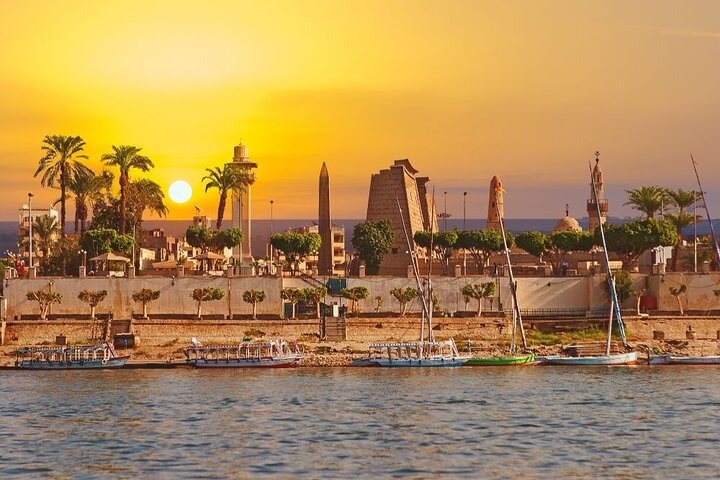Amazing 3 Nights cruise Aswan to Luxor including Hot Air Ballon,Abu simbel
» Hurghada » Hurghada » Hurghada
From $460.00
Price varies by group size
Lowest Price GuaranteePricing Info: Per Person
Duration:
Departs: Hurghada, Hurghada
Ticket Type: Mobile or paper ticket accepted
Free cancellation
Overview
See more of Egypt and check off a Nile cruise with this 3-night experience from Aswan. Offering a convenient and relaxing way to visit Abu Simbel and Luxor, this package includes your hotel transport, Nile cruise ship accommodation, meals, and trips with an Egyptologist guide. Extra highlights include an Abu Simbel small-group tour, a visit to a local family in a Nubian village on Soheil Island, and a Luxor hot air balloon ride.
What's Included
3 nights accommodation on 5 stars Nile Cruise on full board basis.
35 to 45 minutes Hot Air Balloon Ride Over Luxor Sky
5 stars Nile cruise for 2 nights from Aswan to Luxor
All transfers/Pickup and drop off service by A/C. vehicle .
Breakfast x 2
cabin with all facilities
Dinner x 2
Domestic Flight Cairo - Aswan / Luxor - Cairo
Egyptology tour guide
Entry/Admission - Colossi of Memnon
horse and carriage
Hot Air Balloon
Lunch x 2
meals start with lunch end with breakfast third day
pick up and drop off by air conditioning mini bus
Professional English speaking Egyptology Tour guide.
Sharing a small group to Abu Simbel.
taxes and charges
Tour To Aswan High Dam
Tour To Luxor East Bank
Tour To Luxor West Bank
Tour To Temple of Kom Ombo
Tour To Temple Of Phille
What's Not Included
Drinks
Entrance fees
Tipping (recommended)
tipping(recommended)
Traveler Information
- INFANT: Age: 0 - 4
- CHILD: Age: 5 - 11
- ADULT: Age: 12 - 99
Additional Info
- Contactless payments for gratuities and add-ons
- Face masks required for guides in public areas
- Gear/equipment sanitised between use
- Hand sanitiser available to travellers and staff
- Paid stay-at-home policy for staff with symptoms
- Regular temperature checks for staff
- Social distancing enforced throughout experience
- Suitable for all physical fitness levels
- Transportation options are wheelchair accessible
- Wheelchair accessible
- All areas and surfaces are wheelchair accessible
- Face masks provided for travellers
- Face masks required for travellers in public areas
- Guides required to regularly wash hands
- Infants and small children can ride in a pram or stroller
- Public transportation options are available nearby
- Regularly sanitised high-traffic areas
- Specialized infant seats are available
- Temperature checks for travellers upon arrival
- Transportation vehicles regularly sanitised
Cancellation Policy
For a full refund, cancel at least 24 hours before the scheduled departure time.
- For a full refund, you must cancel at least 24 hours before the experience’s start time.
- If you cancel less than 24 hours before the experience’s start time, the amount you paid will not be refunded.
- This experience requires good weather. If it’s canceled due to poor weather, you’ll be offered a different date or a full refund.
What To Expect
Cairo Governorate
• Admission Ticket Free
Aswan
• Admission Ticket Free
Temple of Philae
2 hours • Admission Ticket Not Included
Aswan High Dam
2 hours • Admission Ticket Not Included
Temple of Kom Ombo
2 hours • Admission Ticket Not Included
Temple of Horus
2 hours • Admission Ticket Not Included
Luxor Temple
1 hours • Admission Ticket Not Included
Valley of the Kings
2 hours • Admission Ticket Not Included
Temple of Hatshepsut at Deir el Bahari
1 hours • Admission Ticket Not Included
Colossi of Memnon
The statues were made from blocks of quartzite sandstone that were quarried from Jabal al-Ahmar (near present-day Cairo) and transported 675 km (420 mi) overland to Thebes (Luxor).
30 minutes • Admission Ticket Free
Temple of Karnak
2 hours • Admission Ticket Not Included
« All Activities


























 English (Canada)
English (Canada) Español (Argentina)
Español (Argentina) Español (Chile)
Español (Chile) Español (Colombia)
Español (Colombia) Español (México)
Español (México) Español (Perú)
Español (Perú) Español (Venezuela)
Español (Venezuela) Français (Canada)
Français (Canada) Português (Brasil)
Português (Brasil) English
English Dansk
Dansk Deutsch (Österreich)
Deutsch (Österreich) Deutsch (Schweiz)
Deutsch (Schweiz) Deutsch
Deutsch English (UK)
English (UK) English (Ireland)
English (Ireland) Español
Español Français (Belgique)
Français (Belgique) Français (Suisse)
Français (Suisse) Français
Français Italiano (Svizzera)
Italiano (Svizzera) Italiano
Italiano Nederlands (België)
Nederlands (België) Nederlands
Nederlands Norsk
Norsk Português (Portugal)
Português (Portugal) Svenska
Svenska English (Australia)
English (Australia) English (Hong Kong)
English (Hong Kong) English (India)
English (India) English (Malaysia)
English (Malaysia) English (New Zealand)
English (New Zealand) English (Philippines)
English (Philippines) English (Singapore)
English (Singapore) 日本語
日本語 English (South Africa)
English (South Africa)